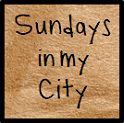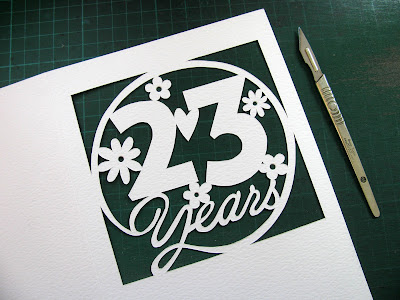"Israel is a small country. You must have seen everything by now!" people often say to me. "Heck no!" I always reply, "There is still plenty for me to see and do!". Having said that, there is absolutely no harm in going back to a place we have previously enjoyed and this Pesach (Passover), when my Dad was visiting from the UK, that is pretty much what we did. Long hikes were off the menu, so I looked for more gentle activities. We were busy!
We made a return visit to
Shoham Forest Park, this time climbing up to
Givat HaSaflulim, "The Hill of Cup Marks", where a lookout point is located in memory of a soldier who fell in battle in Lebanon in 1994. The name of the hill comes from a large rock located there which has various sized depressions carved into it. The small depressions are known as "
cup marks" and may have been formed by cracking nutshells, and the larger ones from crushing grains and herbs. The view from the lookout point was impressive, extending westward toward the coastal plain and eastward towards the
Samaria mountains.
We showed my Dad the ancient church of St. Bacchus with its beautiful mosaic floor, and we checked out the the
Madaba map, which is part of a mosaic floor from the Byzantine period that was discovered in a 19th century church in the city of Madaba, Jordan. It was Pesach of course, so the obligatory Pesach picnic of
matza, boiled eggs and salad was consumed. The kids used to moan about it, but now they just get on with it!
Another day saw us revisiting
Nahal Taninim Nature Reserve in the
Carmel coastal plains. The name of the reserve means
Crocodile River in Hebrew, but we didn't see any crocodiles on this visit nor the previous one. Apparently they haven't been spotted there since 1877! We did however enjoy a leisurely stroll through the reserve, stopping to see the Roman dam and the lake it created, the aqueducts, flour mills and the ancient gravel quarries, one of which was used more recently, in the early part of the 20th century, by
Edmund de Rothschild, who purchased much of the surrounding land and constructed a pipe factory.
Nahal Taninim is beautifully maintained and flowers bloom in many parts of the reserve. It was already too late in the season to see poppies, anemones and asphodels, but bicoloured
Viper’s bugloss and wild
yellow Chrysanthemum added splashes of colour to the antiquities. There was life in the water too and the
catfish were easy to spot as we wandered along the stream.
We came across this exhibition of old posters, below, quite by chance. While I went to see the
Picasso exhibition at Altmans Gallery in Tel Aviv, I suggested that Mister Handmade in Israel and my Dad go to the
Shalom Meir Tower, Israel's first skyscraper, just around the corner. I had popped in to use the bathrooms on a previous visit and had noticed an exhibition of photographs of old Tel Aviv on the ground floor of the building. I thought that my Dad might enjoy seeing them. As it turned out, there are a wide range of exhibits in the lobby and on the first floor. They tell the story of the city of Tel Aviv, illustrating its historic, architectural, and artistic development over 100 years. Exhibits from some of Israel's larger museums are also on display, along with models, maps, and photographs.
The exhibit that I was particularly interested in features adverts and posters from the streets in Tel Aviv's earliest days. Their language, style, and topics embody the atmosphere of those formative years. The adverts include municipal notices, social announcements, and concert and theatre posters that all tell the story of the rich cultural life in Tel Aviv's first years. If we'd had the time, we could literally have spent the day at the Shalom Meir Tower! I will definitely be going back to take a closer look.
The following day we stayed at home but in the evening went to Jerusalem to see the wonderful
Yonina in concert. Yoni and Nina, hence the band name Yonina, are a young religious couple who started out small, by uploading a weekly video to Facebook and YouTube, and in recent months have gained quite a following. Their music, a mix of covers and their own material, is gentle and pure. My Dad was smitten and declared it the best thing we had done all holiday!

We finally convinced the youngest son to join us for one activity!
The Biblical Museum of Natural History, currently located in
Beit Shemesh, is part natural history museum, part zoo, and part
Torah education centre. We joined a tour led by the museum’s director, Rabbi Slifkin, who is affectionately referred to as the "Zoo Rabbi", and learnt about the animals that lived in the time of the Torah and their symbolism in Jewish texts. We saw large taxidermy specimens and skeleton exhibits, and had the pleasure of holding some live animals too. Unfortunately it wasn't the greatest activity we had participated in over the holiday (I think we would have been better off going off-season, when there might be less babies and toddlers in the group), but the youngest son particularly enjoyed holding the snakes, the chameleon and, yes, a tarantula! I was rather partial to the sweet little Siberian hamsters myself.





Our final outing before the end of the holiday was to
The Yitzhak Rabin Centre in Tel Aviv. The centre is the official memorial dedicated to the legacy of the late Israeli Prime Minister,
Yitzhak Rabin, who was assassinated in November 1995 by an extremist who opposed the terms of the
Oslo Accords. It includes one of Israel’s newest museums, the Israeli Museum, which explores the history and development of the modern democratic State of Israel, using the biography of Yitzhak Rabin as a connecting thread. Rabin's story is told in a very interesting manner and we all found ourselves consumed by it. The museum is both emotionally moving and full of information. We spent several hours there.
As an interesting aside, the centre, which was designed by the acclaimed Israeli architect,
Moshe Safdie, was built on the foundations of a top secret power station known as "Reading G" or "J'ora." Built in 1954-1956 to supply power in the event of an enemy bombing, it was financed in part by the
German Reparations Agreement.












































































